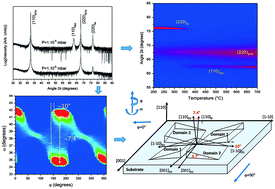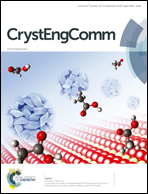Microstructure and oxidation resistance of relaxed epitaxial nickel thin films grown on (100)- and (110)-SrTiO3 substrates by pulsed laser deposition†
Abstract
The relaxed epitaxial growth of Ni thin films has been successfully performed on both (100)- and (110)-oriented SrTiO3 substrates by pulsed laser deposition, as revealed by pole figures realized by X-ray micro-diffraction and rocking curve measurements. In the case of Ni films deposited on the (110)-SrTiO3 substrate, the advanced microstructural X-ray diffraction study (ω-scans vs. φ and reciprocal space maps) evidences the existence of two domains disoriented with respect to the substrate crystallographic axes (both in-plane with +5° and −5° tilts (±1°) and out-of-plane with +3.7° and −3.7° tilts (±0.1°), respectively). Besides the lattice misfit constraints, the layer orientation can also be controlled by strain/surface energy balance. The surface energy modeling of nickel makes it possible to explain the observed growth by low surface energy anisotropy. Furthermore, the high temperature oxidation resistance of the films under air has been studied by in situ high-temperature X-ray diffraction. While the results show the formation of a NiO oxide layer which retains the initial orientation of the Ni film, the Ni corrosion temperature is found to be 500 °C and 375 °C when grown on (100)- and (110)-SrTiO3 substrates, respectively. Such a high corrosion temperature for Ni films grown on the (100)-SrTiO3 substrate is linked to their high density, as observed by atomic force microscopy.



 Please wait while we load your content...
Please wait while we load your content...